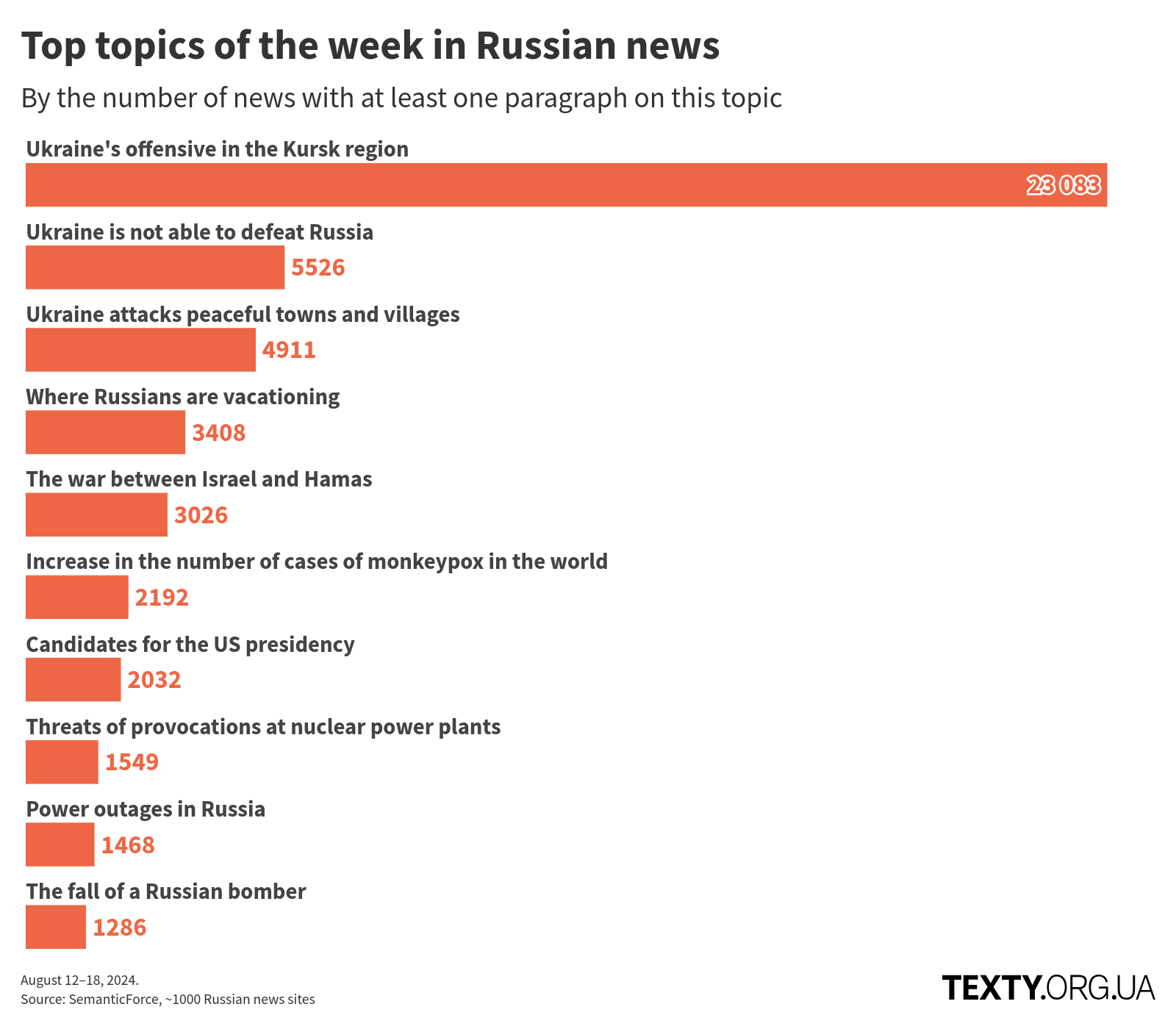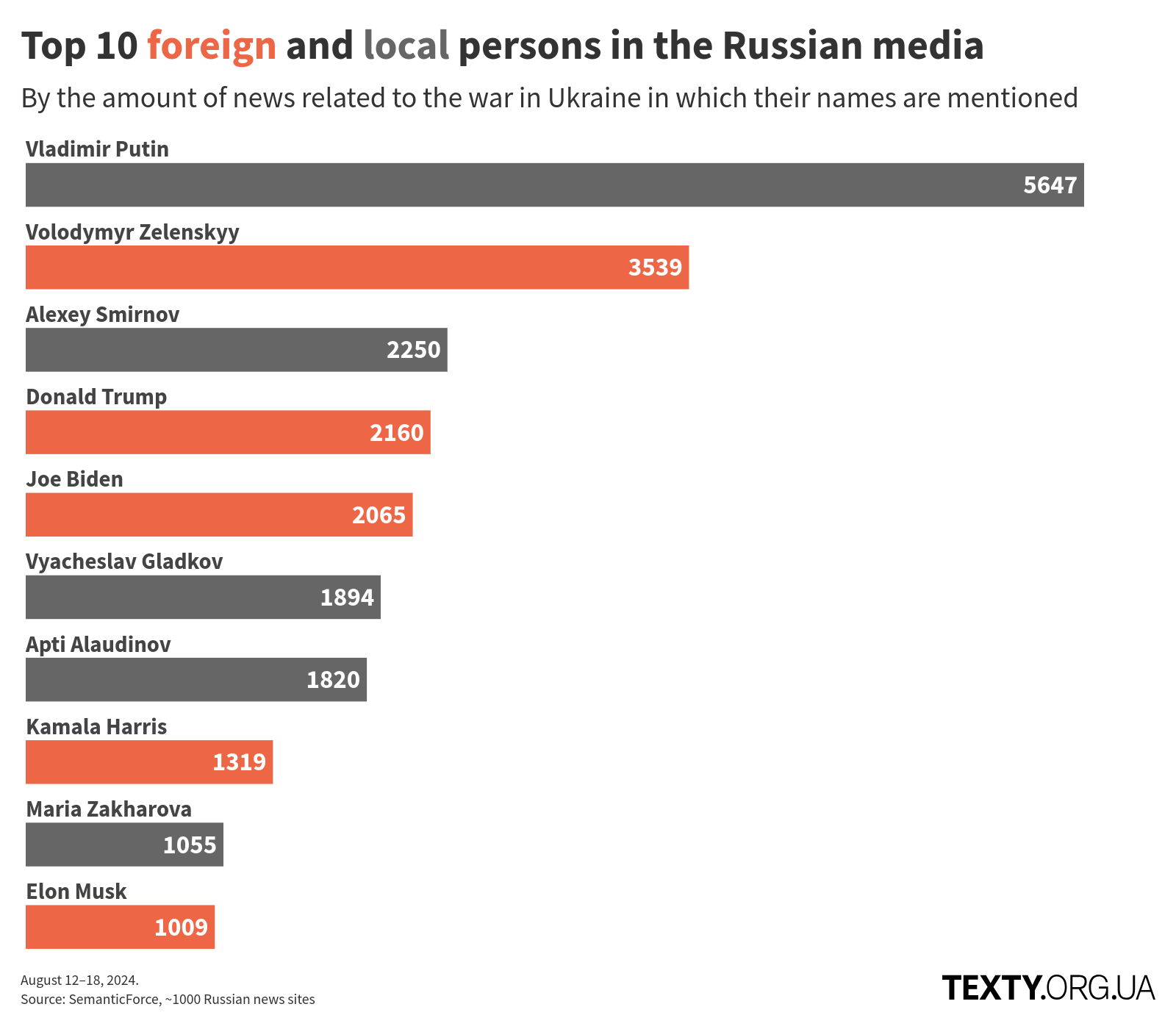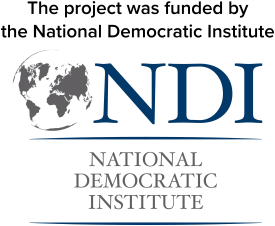Looking for the positive during the Ukrainian offensive. Russian Media Monitoring Report, August 12-18, 2024
Last week, Russian media were forced to focus their attention on the Ukrainian offensive in the Kursk region. The initial stage when propagandists didn't say what happened is over. Now, in particular, they have resorted to the old trick of talking about the future as if it had already come, and predict the future failure of the Ukrainians. They also attribute the temporary success of the Ukrainian Armed Forces to the arrival of Western military equipment. They also accuse the "Ukrainian Nazis" of using Russian civilians as human shields and of chasing them with drones during the evacuation.
Read about this and more in the new issue of our monitoring of Russian state media and manipulative websites that target Russian disinformation.

Ukraine's offensive in the Kursk region
On the second week of the Ukrainian offensive in the Kursk region, the Russian media began to call a spade a spade: the situation was complicated; the Ukrainians were advancing in the Kursk region. At the same time, the news started to include facts: the number of settlements captured, the approximate extent of the occupation, and the number of "disappeared" people.
But this "disappointing" news about the offensive was accompanied by distractions. Today, we will try to analyze them.
Ukraine is facing a full-scale retreat and large-scale shelling
There is nothing that comforts Russians more than dreams of a future Ukrainian retreat. At the same time, propagandists do not restrain themselves in terms of scale: "Everything east of the Dnipro will be lost."
In the meantime, while there is no retreat in the Kursk region, they talk about the allegedly large number of captured Ukrainian prisoners of war. "There have never been so many prisoners at once in the Kursk region," Russian propagandists write about Ukrainian prisoners of war in response to the really disappointing (and confirmed) news for Russians about the largest massive capture of the Russian military.
In order to intimidate Ukrainians and remind Russians of Russia's military might, they were spreading the fake that, allegedly in retaliation for Kursk, "a massive fire strike could be launched against key Ukrainian targets. And it is likely to surpass everything that has happened before."
Ukrainian terrorists torture Russian civilians
From the very beginning of the full-scale invasion, we have been following the Russian thesis of a "human shield" — that the Ukrainian military is "hiding" behind civilians. This thesis has become so popular that it has become a universal explanation for any Russian terrorist act or shelling. Now it is taking on a new form, as Russian propagandists are already presenting Russians as human shields.
"The beautiful words about humanitarian corridors hide only one thing — our people will be used as human shields. This tactic is very popular with the Nazis. In the cities where the Ukrainian Armed Forces are defending themselves, they deliberately do not let residents of apartment buildings out so that our fighters can see that there are civilians in the house and cannot conduct targeted fire or call in artillery."
It is worth noting that the Russian military has never been stopped by the presence of civilians when conducting strikes. In addition, they regularly strike at concentrations of civilians. Since 2014, it has been repeatedly reported that Russia has deployed military equipment in residential areas and even fired from there.
The accusation of using civilians as human shields fits perfectly into one of the examples of demonizing the Ukrainian military. It complemented the stories about the "order to shoot everyone," "bloodthirsty foreign leaders," and "massive cases of looting" with news about bridges being destroyed to prevent civilians from evacuating and quotes from Dmitry Medvedev that Russia is at war with terrorists and therefore needs to destroy the "hornet's nest" (i.e., Ukraine) to remove the "source of threat" to Russia. It should be recalled that Medvedev had repeatedly said that Ukraine needed to be destroyed before the Kursk operation.
This culminated in a fake about the alleged abuse of an elderly man by Ukrainian soldiers in the Kursk region. Gradually, this fake was filled with details about his beating and death, and the Russians even opened a criminal case against the Ukrainian military. This "mockery" manifested in ambiguous jokes and ended with a handshake between the man and the Ukrainian military. According to the Center for Countering Disinformation and the Ministry of Internal Affairs, the man has been found — he is in his home, alive and well. It was also established that he is a citizen of Ukraine.
Ukrainian puppet troops and foreign influence
For the Russians, the main explanation for the success of the Ukrainian Armed Forces due to the efforts of Russian propaganda was foreign weapons and foreign curators. They wrote that "British equipment, including drones," played a central role in the offensive, described the use of British tanks, and "inadvertently" drew attention to the fact that one of the bridges was destroyed by an American "Himars."
Continuing the narrative of foreign interference, the propagandists attacked Italian journalists from the Rai TV channel, who, "in a gross violation of Russian law and basic rules of journalistic ethics," entered the territory of the Kursk region with the Ukrainian military. According to their version, it was all for the sake of "whitewashing propaganda support for the crimes of the Kyiv regime."
After the publication of the Italian report, Russia launched a large-scale campaign to discredit and intimidate Italian journalists, including massive discrediting in the news, personal intimidation, summoning the Italian ambassador to the Russian Foreign Ministry to hand over a note of protest, and even opening a criminal case on "illegal border crossing in Sudzha." All of this is to discourage foreign journalists from covering the actions of the Ukrainian military in the occupied territories from a non-Russian perspective in the future.
Heroizing the "saved": stories of Russian refugees
Along with the growing number of Russian refugees from the Kursk region, there have been more reports about the "heroic" evacuation and avoidance of massacres of ordinary Russians by Ukrainians. There are stories about a hero (as they say, they interviewed a hero) who walked to Sudzha to evacuate his wife and five children. Or about a woman who took her eight children by car, "managing to get away from a Ukrainian drone."
...but the Russians are advancing in Donbas
Still, the main argument is the success of Russian troops on Ukrainian territory. They rejoice that their army is advancing in the Pokrovsk direction, which means that the Ukrainian offensive in Russia has failed to distract the Russian military from Donbas.
To reassure their readers a little more, they began to write more often about air raids in Ukraine and how "residents of Kyiv, Sumy, and Kharkiv regions described strong explosions and fires that were visible tens of kilometers from the places of arrival." As if hoping that the joy of Ukrainian suffering would overwhelm their dissatisfaction with the government's failure to protect their borders.

Trump's conversation with Musk
Elon Musk and Donald Trump held a two-hour public conversation broadcast live on social network X. During this meeting, Trump made at least 20 false statements and provided Russian propagandists with perfect content.
He said the Russo-Ukrainian war would not have started if he, not Biden, had been president of the United States. He said that he planned to get along with Putin and repeated the thesis that it was allegedly talk of Ukraine's membership in NATO that caused the invasion (and not Russia's aggressive ambitions).
The Russian media eagerly quoted Trump's characterization of Putin as a "good negotiator." They also compared Biden to a vegetable, as it coincides with the Russian emphasis on the psychological and physical condition of the current US president.
What else they wrote about
The nuclear threat due to "provocations" by the Ukrainian military
They intimidated that the Armed Forces of Ukraine were going to strike Zaporizhzhia and Kursk NPPs with NATO missiles soon. To make it more convincing, they even gave unconfirmed details about which city these missiles had already been brought to. Once again, they spread fictitious theses about a dirty nuclear bomb (the name given to an incomplete nuclear bomb that will not cause massive destruction but will contaminate a certain area with radiation). However, they added that this bomb would not be used "without the West's permission," thus resolving the internal contradiction of how to write about scary and threatening Ukrainians without mentioning their military power. Therefore, such fakes always contain a thesis about Western control or Western weapons.
The removal of Volodymyr Zelenskyy from the presidency of Ukraine
They discussed who could replace him and explained that all this was to return American favor to the Democratic Party before the US presidential election, as Americans are allegedly increasingly agreeing that Zelenskyy's actions (and his support by Democrats) will lead to nuclear war.
The blocking/slowing down YouTube in Russia
They were happy about the growth of the audience of alternative (Russian) services like VK video or RuTube. And they intimidated that the tools that allegedly allow you to circumvent the restrictions "contain various viruses, encryptors and other Trojans."
If you are interested in receiving an extended version of our monitoring report, please fill out this brief questionnaire.
The Methodology
To monitor the information published on disinformation websites, we analyzed approximately 500,000 news reports collected from ~ 1,000 Russian websites. The data for the analysis was collected and provided by SemanticForce.
Each paragraph was processed using an algorithm which defines its topic automatically. The resulting topics (i.e. groups with similar content) were short-listed by the topics relating to the war or its consequences for Russia. The number of mentions of a certain topic was then counted for each publication. Our conclusions are based on the respective findings and the quotes from paragraphs referring to each topic.

This article was originally written in Ukrainian. It has been translated into English using AI tools such as DeepL, ChatGPT, and Grammarly. If you encounter an error that requires immediate attention, please inform us via Facebook, Twitter, or Instagram. Your understanding and support are appreciated.

